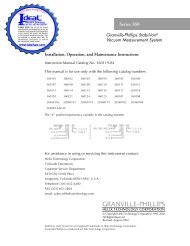Leybold D65BCS, D40BCS, Instruction Manual - Ideal Vacuum ...
Leybold D65BCS, D40BCS, Instruction Manual - Ideal Vacuum ...
Leybold D65BCS, D40BCS, Instruction Manual - Ideal Vacuum ...
Create successful ePaper yourself
Turn your PDF publications into a flip-book with our unique Google optimized e-Paper software.
Troubleshooting<br />
4 Troubleshooting<br />
Fault Possible cause Remedy Repair*<br />
Pump does not<br />
start.<br />
Wiring is malfunctioning.<br />
Motor protection switch incorrectly set<br />
(3-phase motors only).<br />
Operating voltage does not match motor.<br />
Motor is malfunctioning.<br />
Oil temperature is below 12 °C.<br />
Oil is too viscous.<br />
Exhaust filter or exhaust line is clogged.<br />
Pump is seized up (sign: pump is jammed).<br />
Check and repair wiring.<br />
Set motor protection switch properly.<br />
Replace the motor.<br />
Replace the motor.<br />
Heat the pump and pump oil or use different oil.<br />
Change the oil.<br />
Replace the filter or clean the exhaust line.<br />
Repair the pump.<br />
-<br />
2.3<br />
3.5<br />
3.5<br />
2.5.3/3.2<br />
3.2<br />
-<br />
Service<br />
Pump does not<br />
reach ultimate pressure.<br />
Measuring technique or gauge is unsuitable.<br />
External leak 1) .<br />
Anti-suckback valve is malfunctioning.<br />
Exhaust valve is malfunctioning.<br />
Oil is unsuitable.<br />
Intake line is dirty.<br />
Pump is too small.<br />
Use correct measuring technique and gauge.<br />
Measure the pressure directly at pump’s intake port.<br />
Repair the pump.<br />
Repair the valve.<br />
Repair the valve.<br />
Change the oil (degas it, if necessary).<br />
Clean vacuum lines.<br />
Check the process data; replace the pump, if necessary.<br />
-<br />
Service<br />
Service<br />
Service<br />
3.2<br />
-<br />
-<br />
Pumping speed is<br />
too low.<br />
Dirt trap in the intake port is clogged.<br />
Exhaust filter is clogged.<br />
Connecting lines are too narrow or too long.<br />
Clean the dirt trap;<br />
Precaution: install a dust filter in intake line.<br />
Exchange the filter element.<br />
Use adequately wide and short connecting lines.<br />
3.3<br />
-<br />
2.2<br />
After switching off<br />
pump under vacuum,<br />
pressure in<br />
system rises too<br />
fast.<br />
System has a leak.<br />
Anti-suckback valve is malfunctioning.<br />
Check the system.<br />
Repair the valve.<br />
-<br />
Service<br />
Pump gets hotter<br />
than usually observed.<br />
Cooling air supply is obstructed.<br />
Ambient temperature is too high.<br />
Process gas is too hot.<br />
Oil level is too low.<br />
Oil is unsuitable.<br />
Oil cycle is obstructed.<br />
Exhaust filter or exhaust line is obstructed.<br />
Exhaust valve is malfunctioning.<br />
Pump module is worn out.<br />
Set pump up correctly.<br />
Set pump up correctly.<br />
Change the process.<br />
Add oil.<br />
Change the oil.<br />
Clean or repair the oil lines and channels.<br />
Replace the exhaust filter, clean the exhaust line.<br />
Repair the valve.<br />
Replace the pump module.<br />
2.1<br />
2.1/2.5.3<br />
-<br />
3.2<br />
3.2<br />
Service<br />
-<br />
Service<br />
3.7<br />
Oil in the intake line<br />
or in vacuum vessel.<br />
Oil comes from the vacuum system.<br />
Anti-suckback valve is obstructed.<br />
Sealing surfaces of anti-suckback valve are damaged or dirty.<br />
Oil level is too high.<br />
Check the vacuum system.<br />
Clean or repair the valve.<br />
Clean or repair the intake port and the anti-suckback valve.<br />
Drain the excess oil.<br />
-<br />
Service<br />
Service<br />
3.2<br />
Oil is turbid. Condensation. Degas the oil or change the oil and clean the pump. Precaution:<br />
open the gas ballast valve or insert a condensate trap.<br />
2.5.2/3.2<br />
Pump is excessively<br />
noisy.<br />
Oil level is much too low (oil is no longer visible).<br />
Silencing nozzle is clogged.<br />
Intake pressure is too high.<br />
Internal demister is clogged.<br />
Coupling element is worn.<br />
Vanes or bearings are damaged.<br />
Add oil.<br />
Clean or replace the silencing nozzle.<br />
Lower the intake pressure.<br />
Clean or replace demister.<br />
Install new coupling element.<br />
Repair pump.<br />
3.2<br />
Service<br />
-<br />
3.4<br />
3.5<br />
Service<br />
* Repair information: refer to the Chapter in the Operation <strong>Instruction</strong> stated here.<br />
1) Bubble test: the warm pump with degassed oil is running without gas ballast and the intake blanked off. The exhaust line is led in to a vessel with water. If an evenly<br />
spaced line of bubbles appears, then the pump has an external leak.<br />
30 GA 01.301/6.02 - 05/01

















